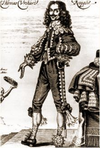
A | B | C | D | E | F | G | H | CH | I | J | K | L | M | N | O | P | Q | R | S | T | U | V | W | X | Y | Z | 0 | 1 | 2 | 3 | 4 | 5 | 6 | 7 | 8 | 9
List of unusual deaths
...

This list of unusual deaths includes unique or extremely rare circumstances of death recorded throughout history, noted as being unusual by multiple sources.
Antiquity
| Name of person | Image | Date of death | Details |
|---|---|---|---|
| Menes |  |
c. 3200 BC | According to Manetho, the Egyptian pharaoh and unifier of Upper and Lower Egypt was carried off and then killed by a hippopotamus.[2][3] |
| Draco of Athens | c. 620 BC | The Athenian lawmaker was reportedly smothered to death by gifts of cloaks and hats showered upon him by appreciative citizens at a theatre in Aegina, Greece.[4][5] | |
| Charondas |  |
c. 612 BC | According to Diodorus Siculus, the Greek lawgiver from Sicily issued a law that anyone who brought weapons into the Assembly must be put to death. One day, he arrived at the Assembly seeking help to defeat some brigands in the countryside, but with a knife still attached to his belt. In order to uphold his own law, he committed suicide.[6][7][8] |
| Arrhichion of Phigalia |  |
564 BC | The Greek pankratiast caused his own death during the Olympic finals. Held by his unidentified opponent in a stranglehold and unable to free himself, Arrhichion kicked his opponent, causing him so much pain from a foot/ankle injury that the opponent made the sign of defeat to the umpires, but at the same time broke Arrhichion's neck. Since the opponent had conceded defeat, Arrhichion was proclaimed the victor posthumously.[9][10] |
| Milo of Croton |  |
6th century BC | The Olympic champion wrestler's hands reportedly became trapped when he tried to split a tree apart; he was then devoured by wolves (or, in later versions, lions).[11] |
| Zeuxis |  |
5th century BC | The Greek painter died of laughter while painting an elderly woman.[12][13] |
| Pythagoras of Samos |  |
c. 495 BC | Ancient sources disagree on how the Greek philosopher died,[14][15] but one late and probably apocryphal legend reported by both Diogenes Laërtius, a third-century AD biographer of famous philosophers, and Iamblichus, a Neoplatonist philosopher, states that Pythagoras was murdered by his political enemies. Supposedly, he almost managed to outrun them, but he came to a bean field and refused to run through it, as he had prohibited beans as ritually unclean.[15][16] Since cutting through the field would violate his own teachings, Pythagoras simply stopped running and was killed. This story may have been fabricated by Neanthes of Cyzicus, on whom both Diogenes and Iamblichus rely as a source.[15] |
| Anacreon |  |
c. 485 BC | The poet, known for works in celebration of wine, choked to death on a grape stone according to Pliny the Elder. The 1911 Encyclopædia Britannica suggests that "the story has an air of mythical adaptation to the poet's habits".[12]: 104 [17] |
| Heraclitus of Ephesus |  |
c. 475 BC | According to one account given by Diogenes Laërtius, the Greek philosopher was said to have been devoured by dogs after smearing himself with cow manure in an attempt to cure his dropsy.[18][19] |
| Themistocles | 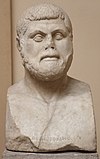 |
c. 459 BC | The Athenian general who won the Battle of Salamis actually died of natural causes in exile,[20][21] but was widely rumored to have committed suicide by drinking a solution of crushed minerals known as bull's blood.[20][21][22][23] The legend is widely retold in classical sources. The early twentieth-century English classicist Percy Gardner proposed that the story about him drinking bull's blood may have been based on an ignorant misunderstanding of a statue showing Themistocles in a heroic pose, holding a cup as an offering to the gods. The comedic playwright Aristophanes references Themistocles drinking bull's blood in his comedy The Knights (performed in 424 BC) as the most heroic way for a man to die.[21][24] |
| Aeschylus | 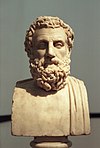 |
c. 455 BC | According to Valerius Maximus, the eldest of the three great Athenian tragedians was killed by a tortoise dropped by an eagle that had mistaken his bald head for a rock suitable for shattering the shell of the reptile. Pliny the Elder, in his Natural History, adds that Aeschylus had been staying outdoors to avert a prophecy that he would be killed that day "by the fall of a house".[12]: 104 [25][26][27] |
| Empedocles of Akragas |  |
c. 430 BC | According to Diogenes Laërtius, the Pre-Socratic philosopher from Sicily, who, in one of his surviving poems, declared himself to have become a "divine being... no longer mortal",[28] tried to prove he was an immortal god by leaping into Mount Etna, an active volcano.[29][30] This legend is also alluded to by the Roman poet Horace.[31] |
| Sophocles |  |
c. 406 BC | A number of "remarkable" legends concerning the death of another of the three great Athenian tragedians are recorded in the late antique Life of Sophocles. According to one legend, he choked to death on an unripe grape. Another says that he died of joy after hearing that his last play had been successful. A third account reports that he died of suffocation, after reading aloud a lengthy monologue from the end of his play Antigone, without pausing to take a breath for punctuation.[27] |
| Mithridates | 401 BC | The Persian soldier who embarrassed his king, Artaxerxes II, by boasting of killing his rival, Cyrus the Younger (who was the brother of Artaxerxes II), was executed by scaphism. The king's physician, Ctesias, reported that Mithridates survived the insect torture for 17 days.[32][33] | |
| Democritus of Abdera | 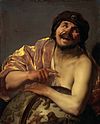 |
c. 370 BC | According to Diogenes Laërtius, the Greek Atomist philosopher died aged 109; as he was on his deathbed, his sister was greatly worried because she needed to fulfill her religious obligations to the goddess Artemis in the approaching three-day Thesmophoria festival. Democritus told her to place a loaf of warm bread under his nose, and was able to survive for the three days of the festival by sniffing it. He died immediately after the festival was over.[34][35] |
| Antiphanes | c. 310 BC | According to the Suda, the renowned comic poet of the Middle Attic comedy died after being struck by a pear.[36][37] | |
| Agathocles of Syracuse |  |
289 BC | The Greek tyrant of Syracuse was murdered with a poisoned toothpick.[12]: 104 [38] |
| Philitas of Cos | 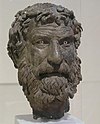 |
c. 270 BC | The Greek intellectual is said by Athenaeus to have studied arguments and erroneous word usage so intensely that he wasted away and starved to death.[39] British classicist Alan Cameron speculates that Philitas died from a wasting disease which his contemporaries joked was caused by his pedantry.[40] |
| Zeno of Citium |  |
c. 262 BC | The Greek philosopher from Citium (Kition), Cyprus, tripped and fell as he was leaving the school, breaking his toe. Striking the ground with his fist, he quoted the line from the Niobe, "I come, I come, why dost thou call for me?" He died on the spot through holding his breath.[41] |
| Qin Shi Huang | 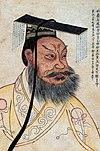 |
August 210 BC | The first emperor of China, whose artifacts and treasures include the Terracotta Army, died after ingesting several pills of mercury, in the belief that it would grant him eternal life.[42][43][44] |
| Chrysippus of Soli |  |
c. 206 BC | One ancient account of the death of the third-century BC Greek Stoic philosopher tells that he died of laughter after he saw a donkey eating his figs; he told a slave to give the donkey neat wine to drink with which to wash them down, and then, "...having laughed too much, he died" (Diogenes Laërtius 7.185).[45] |
| Eleazar Avaran |  |
c. 163 BC | The brother of Judas Maccabeus; according to 1 Maccabees 6:46, during the Battle of Beth Zechariah, Eleazar spied an armored war elephant which he believed to be carrying the Seleucid emperor Antiochus V Eupator. After thrusting his spear in battle into its belly, it collapsed and fell on top of Eleazar, killing him instantly.[46] |
| Manius Aquillius and Marcus Licinius Crassus |   |
1st Century BC | The late Roman Republic-era consul was sent as ambassador to Asia Minor in 90 BC to restore Nicomedes IV of Bithynia to his kingdom after the latter was expelled by Mithridates VI of Pontus. But Aquillius encouraged Nicomedes to raid part of Mithridates' territory, which started the First Mithridatic War. Aquillius was captured and brought to Mithridates, who in 88 BC had him executed by pouring molten gold down his throat. According to one story, Marcus Licinius Crassus, a Roman general and statesman, who was very greedy despite being called "the richest man in Rome," was executed in the same manner by the Parthians after they defeated him in the Battle of Carrhae in 53 BC, in symbolic mockery of his thirst for wealth. However, it has been disputed as to whether this is how Crassus met his end.[47] |
| Porcia Catonis |  |
June 43 BC to October 42 BC | The daughter of Marcus Porcius Cato Uticensis and second wife of Marcus Junius Brutus, according to ancient historians such as Cassius Dio and Appian, killed herself by swallowing hot coals.[48] Modern historians find this tale implausible.[49] |
| Claudius Drusus |  |
c. 20 AD | According to Suetonius, the eldest son of the future Roman emperor Claudius died while playing with a pear. Having tossed the pear high in the air, he caught it in his mouth when it came back, but he choked on it, dying of asphyxia.[50] |
| Tiberius |  |
16 March 37 | The Roman emperor died in Misenum aged 78. According to Tacitus, the emperor appeared to have died and Caligula, who was at Tiberius' villa, was being congratulated on his succession to the empire, when news arrived that the emperor had revived and was recovering his faculties. Those who had moments before recognized Caligula as Augustus fled in fear of the emperor's wrath, while Macro, a prefect of the Praetorian Guard, took advantage of the chaos to have Tiberius smothered with his own bedclothes, definitively killing him.[51] |
| Simon Peter |  |
Between 64 and 68 AD | The apostle of Jesus was crucified upside-down in Rome, based on his claim of being unworthy to die in the same way as his Saviour.[52][53] |
| Simon the Zealot |  |
1st century AD | According to an ancient tradition, the apostle of Jesus, was sawn in half in Persia.[54] |
| Saint Lawrence |  |
258 | The deacon was roasted alive on a giant grill during the persecution of Valerian.[55][56] Prudentius tells that he joked with his tormentors, "Turn me over—I'm done on this side".[57] He is now the patron saint of cooks, chefs, and comedians.[58] |
| Marcus of Arethusa | 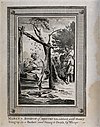 |
362 | The Christian bishop and martyr was hung up in a honey-smeared basket for bees to sting him to death.[12]: 104 |
| Valentinian I |  |
17 November 375 | The Roman emperor suffered a stroke which was provoked by yelling at foreign envoys in anger.[59] |
Middle Ages
| Name of person | Image | Date of death | Details |
|---|---|---|---|
| Constans II |  |
15 July 668 | The Byzantine Emperor was assassinated with a bucket according to Theophilus of Edessa.[60] |
| Ragnar Lodbrok |  |
c. 865 | The semi-legendary Viking leader whose exploits are narrated in the Ragnars saga loðbrókar, a thirteenth-century Icelandic saga, is said to have been captured by Ælla of Northumbria, who had him executed by throwing him into a pit of snakes.[61] |
| Louis III of France | 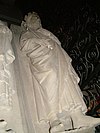 |
5 August 882 | The king of West Francia, died aged around 18 at Saint-Denis. Whilst mounting his horse to pursue a girl who was running to seek refuge in her father's house, he hit his head on the lintel of a low door and fell, fracturing his skull.[62] |
| Basil I |  |
29 August 886 | The Byzantine emperor's belt was entangled between antlers of a deer during a hunt and the animal subsequently dragged him for 16 miles (26 km) through the woods. Because of this accident, Basil contracted fever and he died shortly afterwards.[63] |
| Sigurd the Mighty of Orkney |
892 | The second Earl of Orkney strapped the head of his defeated foe Máel Brigte to his horse's saddle. Brigte's teeth rubbed against Sigurd's leg as he rode, causing a fatal infection, according to the Old Norse Heimskringla and Orkneyinga sagas.[64] | |
| Edmund Ironside |  |
30 November 1016 | The English king was allegedly stabbed whilst on a toilet by an assassin hiding underneath.[65] |
| Béla I of Hungary | 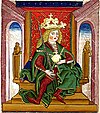 |
11 September 1063 | After the Holy Roman Empire decided to launch a military expedition against Hungary to restore young Solomon to the throne, the Hungarian king was seriously injured when "his throne broke beneath him" in his manor at Dömös.[66] The king—who was "half-dead", according to the Illuminated Chronicle—was taken to the western borders of his kingdom, where he died at the creek Kanizsa on 11 September 1063.[67][68] |
| Crown Prince Philip of France |
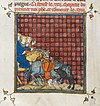 |
13 October 1131 | Died while riding through Paris when his horse tripped over a black pig that was running out of a dung heap.[69] |
| Henry I of England | 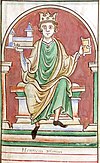 |
1 December 1135 | While visiting relatives, he supposedly ate too many lampreys against his physician's advice, causing a pain in his gut, and ultimately his death.[70] |
| John II Komnenos |  |
1 April 1143 | Cut himself with a poisoned arrow during a boar hunt, and subsequently died from an infection.[71] |
| Victims of the Erfurt latrine disaster |  |
26 July 1184 | While Henry VI, the King of Germany, was holding an informal assembly at the Petersburg Citadel in Erfurt, the combined weight of the assembled nobles caused the wooden second story floor of the building to collapse. Most of the nobles fell through into the latrine cesspit below the ground floor, where about 60 of them drowned in liquid excrement.[72] |
| Henry I of Castile |  |
6 June 1217 | The 13-year-old king of Castile was killed by a tile that fell from a roof.[73] |
| Al-Musta'sim |  |
20 February 1258 | The last Abbasid Caliph of Baghdad, was executed by his Mongol captors by being rolled up in a rug and then trampled by horses.[74] |
| Edward II of England |  |
21 September 1327 | The English king was rumoured to have been murdered after being deposed and imprisoned by his wife Isabella and her lover Roger Mortimer, by having a horn pushed into his anus through which a red-hot iron was inserted, burning out his internal organs without marking his body.[75][76] However, there is no real academic consensus on the manner of Edward II's death, and it has been plausibly argued that the story is propaganda.[77] |
| John of Bohemia |  |
26 August 1346 | After being blind for 10 years, the Bohemian king died in the Battle of Crécy when—at his command—his companions tied their horses' reins to his own and charged. He was slaughtered in the ensuing fight.[78][79] |
| Charles II of Navarre |  |
1 January 1387 | The contemporary chronicler Froissart relates that the king of Navarre, known as "Charles the Bad", suffering from illness in old age, was ordered by his physician to be tightly sewn into a linen sheet soaked in distilled spirits. The highly flammable sheet accidentally caught fire, and Charles later died of his injuries. Froissart considered the horrific death to be God's judgment upon the king.[80][81][82] |
| Martin of Aragon |  |
31 May 1410 | The Aragonese king died from a combination of indigestion and uncontrollable laughing. According to legend, Martin was suffering from indigestion, caused by eating an entire goose, when his favorite jester, Borra, entered the king's bedroom. When Martin asked Borra where he had been, the jester replied with: "Out of the next vineyard, where I saw a young deer hanging by his tail from a tree, as if someone had so punished him for stealing figs." This joke caused the king to die from laughter.[83][84] |
Renaissance
| Name of person | Image | Date of death | Details |
|---|---|---|---|
| George Plantagenet, Duke of Clarence |  |
18 February 1478 | The 1st Duke of Clarence was allegedly executed by drowning in a barrel of Malmsey wine, apparently his own choice once he accepted he was to be killed.[85] |
| Charles VIII of France |  |
7 April 1498 | The French king died as the result of striking his head on the lintel of a door while on his way to watch a game of real tennis.[12]: 105 |
| Victims of the 1518 dancing plague |  |
July 1518 | Several people died of either heart attacks, strokes or exhaustion during a dancing mania that occurred in Strasbourg, Alsace (Holy Roman Empire).[86][87] |
| Pietro Aretino | 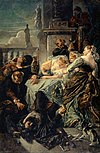 |
21 October 1556 | The influential Italian author and libertine is said to have died of suffocation from laughing too much at an obscene joke during a meal in Venice. Another version states that he fell from a chair from too much laughter, fracturing his skull.[88] |
| Henry II of France |  |
10 July 1559 | On 30 June 1559, a tournament was held near Place des Vosges to celebrate the Peace of Cateau-Cambrésis with the French king's longtime enemies, the Habsburgs of Austria, and to celebrate the marriage of his daughter Elisabeth of Valois to King Philip II of Spain. During a jousting match, Henry, wearing the colors of his mistress Diane de Poitiers,[89] was wounded in the eye by a fragment of the splintered lance of Gabriel Montgomery, captain of the King's Scottish Guard.[90] Despite the efforts of royal surgeons Ambroise Paré and Andreas Vesalius, the court doctors ultimately "advocated a wait-and-see strategy";[91] as a result, the king's untreated eye and brain damage led to his death by sepsis ten days later.[92] His death played a significant role in the decline of jousting as a sport, particularly in France.[93] |
| Hans Staininger |  |
1567 | The burgomaster of Braunau (then Bavaria, now Austria), died when he broke his neck by tripping over his own beard.[94] The beard, which was 4.5 feet (1.4 m) long at the time, was usually kept rolled up in a leather pouch.[95] |
| Marco Antonio Bragadin | 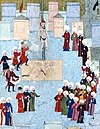 |
17 August 1571 | The Venetian Captain-General of Famagusta in Cyprus, was gruesomely killed after the Ottomans took over the city. He was dragged around the walls with sacks of earth and stone on his back; next, he was tied to a chair and hoisted to the yardarm of the Turkish flagship, where he was exposed to the taunts of the sailors. Finally, he was taken to his place of execution in the main square, tied naked to a column, and flayed alive.[96] Bragadin's skin was stuffed with straw and sewn, reinvested with his military insignia, and exhibited riding an ox in a mocking procession along the streets of Famagusta. The macabre trophy was hoisted upon the masthead pennant of the personal galley of the Ottoman commander, Amir al-bahr Mustafa Pasha, to be taken to Constantinople as a gift for Sultan Selim II. Bragadin's skin was stolen in 1580 by a Venetian seaman and brought back to Venice, where it was received as a returning hero.[97] |
| Tycho Brahe |  |
24 October 1601 | The astronomer contracted a bladder or kidney ailment after attending a banquet in Prague, and died eleven days later. According to Johannes Kepler's first-hand account, Brahe had refused to leave the banquet to relieve himself, because it would have been a breach of etiquette.[98][99] After he had returned home, he was no longer able to urinate, except eventually in very small quantities and with excruciating pain.[100] Though initially ascribed to a kidney stone, and later still to potential mercury poisoning, modern analyses indicate Brahe's death resulted from a fatal case of uremia caused by an inflamed prostate.[101][102] |


